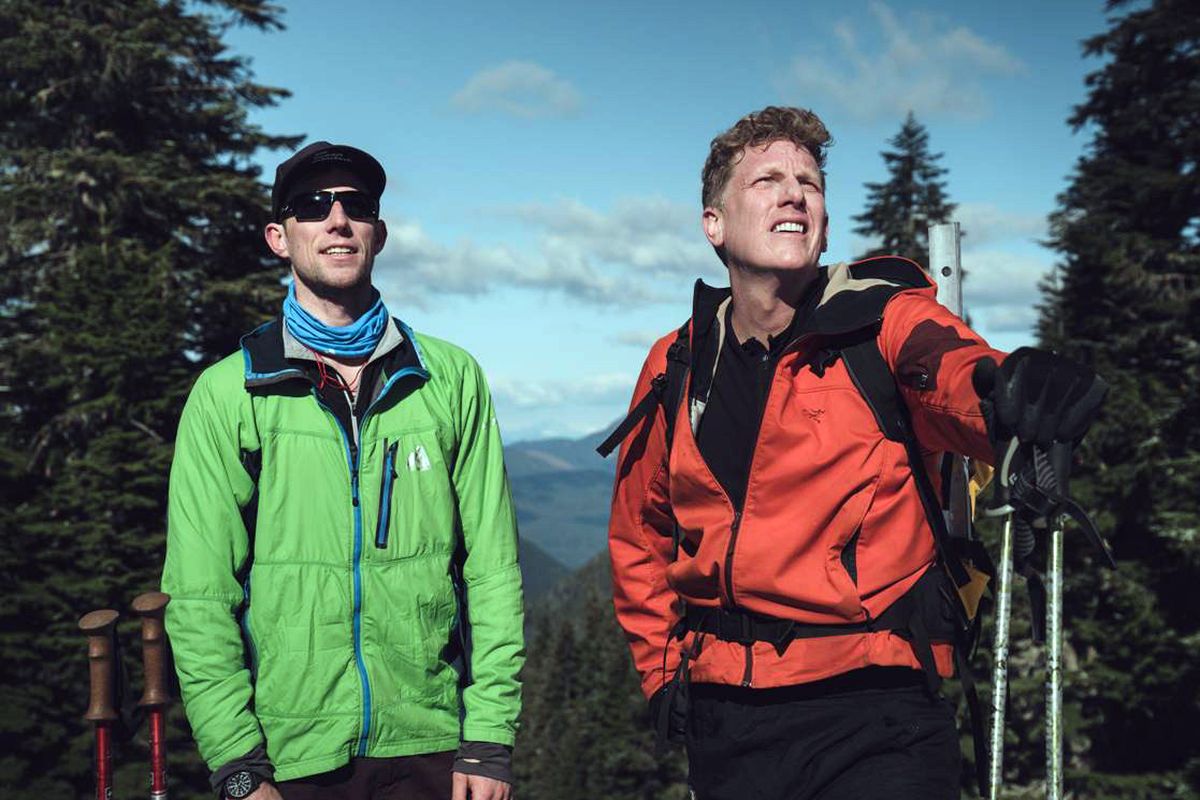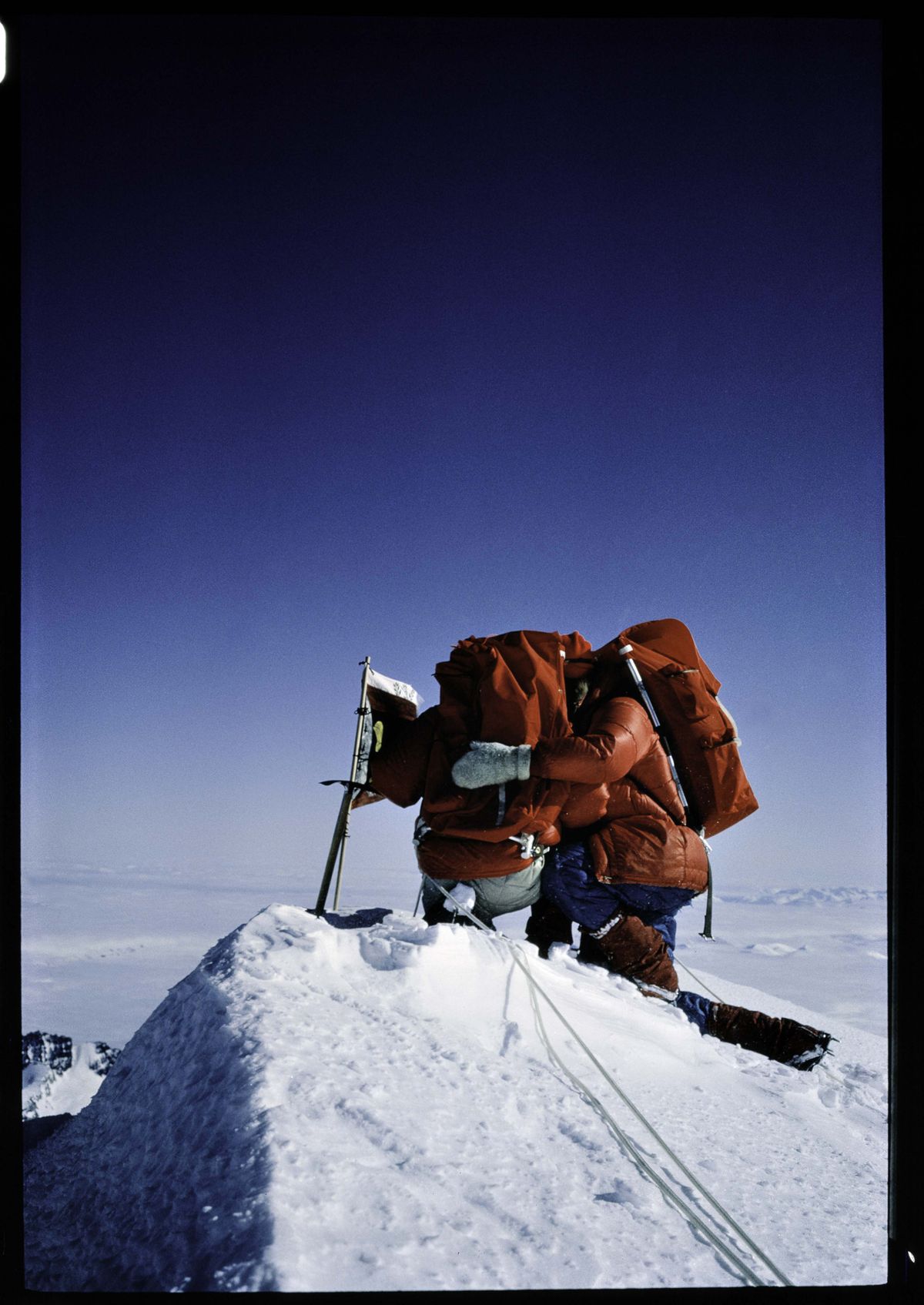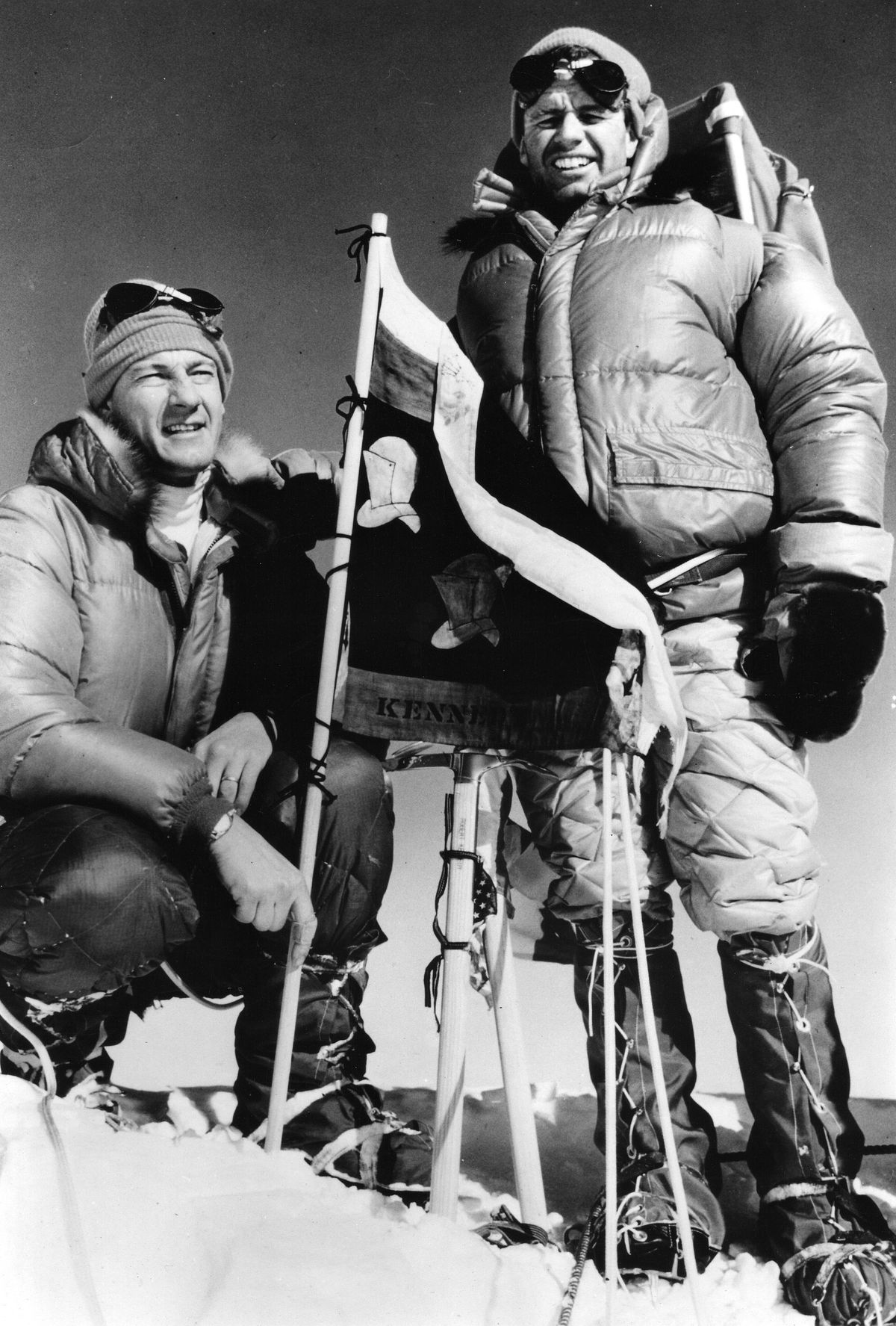Whittaker legend lives on 50 years after Kennedy climb
Jim Whittaker, left, and Robert Kennedy reach the summit of Mount Kennedy on March 24, 1965. (Albert Allard photo (National Geographic) courtesy of Whittaker Family Collection)
On Tuesday, Bobby Whittaker, 48, was driving from his Seattle home for a morning workout on Mount Si when he answered the phone.
“It’s a 4-mile grunt with 3,150 feet of elevation gain close to home,” he said, noting that he’d need all the training he can get to follow in the footsteps of his brother – and father.
Jim Whittaker also made time for an interview to commemorate March 24, the 50th anniversary of the first ascent of Mount Kennedy.
At 86, he’s an inch shorter than the 6-foot-5 mountaineering machine who, in 1963, became the first American to stand on the top of Mount Everest. But he seemed to enjoy a break from skiing in Canada to talk about climbing history and the plans his sons have for repeating it.
After the Everest expedition, President John F. Kennedy presented Whittaker with the Hubbard Medal for distinction in exploration. “We immediately hit it off,” Whittaker said. “Then, just five months later, the president was assassinated in Dallas.”
Whittaker connected with the Kennedys. The man who’d trained 10th Mountain Division troops in winter skills gave skiing lessons to John Jr. and Caroline. He became Robert F. Kennedy’s 1968 presidential campaign manager and was with RFK the night he was gunned down.
Instead of trekking on to a likely appointment as Interior Secretary, he took a spot among RFK’s pallbearers.
But before that, they climbed the mountain.
The Canadian government had christened the country’s highest unclimbed peak in memory of JFK. Explorer Bradford Washburn was intrigued that Yukon’s newly dubbed Mount Kennedy and much of the St. Elias Mountains within Kluane National Park was virtually unmapped.
Washburn organized an exploratory expedition of experienced climbers sponsored by the National Geographic Society. Jim Whittaker would be the leader. RFK showed interest.
Mount Kennedy is a mere 13,944 feet in elevation and not a major mountaineering feat. Even though Kennedy was flown by helicopter to the base camp, the three days of climbing and descending were covered by media across the nation and included in issues of Life and National Geographic magazines.
It’s the human moments that separate the average from the captivating experiences in life, Whittaker said.
He admired RFK for his guts to honor his brother by exchanging his suit and tie for climbing clothes and attempt climbing to a summit where no other man had stood.
When Whittaker checked in with RFK before the climb and asked what he was doing to get in shape, the Senator replied, “Running up and down the stairs and practicing hollering ‘Help!’”
“Rose Kennedy, Bobby’s mom, had only a few words of advice when he left to climb in 1965,” Whittaker recalled. “‘Just be careful. Don’t slip, dear.’ ”
“My dad tells me when Bobby Kennedy arrived in Seattle, all he had with him in the way of outdoor equipment was Abercrombie & Fitch sailing gear,” said Bobby Whittaker, who’s named after RFK.
Jim Whittaker, who’d recently become the first paid employee of Recreational Equipment, Inc., drove RFK to the Seattle store and got him properly outfitted.
“They left for the Yukon the next morning,” Bobby Whittaker said.
“(RFK) was willing to take the risk of losing face,” Jim said. “I told him I didn’t know if we could get the mountain. The area is remote. You can’t control the mountains.”
Despite the obvious difference of altitude, Kennedy and Everest presented some of the same challenges to climbers.
“Both had unknowns,” Whittaker said. “Everest had been climbed before we got there, but no route was marked. Kennedy is about the same elevation as Rainier, but it hadn’t been done. Its altitude is still an issue for people coming from sea level. It has glaciers, crevasses, storms, rock faces, avalanches, cornices.”
No matter how good you are, those are factors that can shut down an expedition – or snuff out a life, he said.
Whittaker was leading a rope team with RFK behind him the first day of the climb to a high-camp snow cave.
“I was trying to do the guide step and set a nice, even pace when I hear this breathing behind me,” he said. “It’s Bobby coming up faster. I tell him we can’t have that much slack in the rope or we’re going to get a hell of a jerk if somebody goes into a crevasse.
“Bobby said, ‘Then can you speed up, Jim?’
“That’s when I knew we were going to get the mountain.”
The next day, after muscling up a short steep section, Whittaker let RFK walk first to the summit, where he bowed down on one knee in a prayer for his brother.
“The tears froze on our parkas,” Whittaker said.
He knelt, too, and offered comfort and congratulations to RFK. The moment was captured by National Geographic photographer Albert Allard.
The photo was enlarged and hanging in Jim Whittaker’s home office when RFK visited a year later. Bobby Whittaker said RFK signed the photo with the comment, “I’m the one helping HIM.”
“He wrote on the glass that was over the print,” Bobby said. “But the glass broke in a move and – I could kick my dad for this – he threw the pieces in the trash.”
Jim Whittaker enjoys the plan two of his sons, Bobby, and youngest son, Leif, 30, have hatched to climb Mount Kennedy and film a documentary about the historic 1965 expedition.
“I don’t have to give them much advice,” he said. “Certainly not to Leif, who’s been up Everest twice and climbed around the world.
“Bobby has done less climbing, but he knows what a crevasse is and how to rope up.”
Both of the “boys” are in the 6-foot-5 range like their dad. “Being tall is good for grabbing that little handhold that might be a little higher than maybe you should reach,” Jim said.
Following the footsteps of his famous namesake would be a powerful moment, Bobby Whittaker said.
“I was born in ‘66, so my memories of the Kenney climb were from walking down the halls our home and seeing photos of RFK on the wall and looking at the National Geographic magazines,” he said.
“The older I get, the more intrigued I am about the mountain and that expedition. To me it means a lot more than going on a climb.”
Jim Whittaker didn’t have to mix climbing with politics. His Everest fame soared him into the social stratosphere, launched REI into an outdoor industry leader and landed Seattle as an outdoor adventure capital.
Politics is riskier than climbing, he said, but the world is shaped by elections. “Bobby (Kennedy) had environmental principles; I merely climbed mountains.
“If people don’t know the importance of forests, mountains and fresh water, how would they vote for them?” he said. “That’s been my thrust. Get them out into the mountains and onto the ocean so they learn to love them and want to protect them and pass them on to future generations.”
He’s famous for saying, “If you aren’t living on the edge, you are taking up too much space.”
He preaches a message called No Child Left Inside.
And he’s glad his sons are taking up the banner.
“Pops is pretty much unstoppable,” Bobby said, remarking on his drive to promote environmental stewardship.
“It’s 30 hours to Whitehorse, but he said, ‘I’ll drive up and meet you after the climb – if you make it.’”


